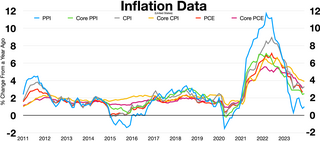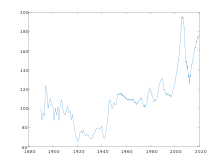
A consumer price index (CPI) is a price index, the price of a weighted average market basket of consumer goods and services purchased by households. Changes in measured CPI track changes in prices over time. The CPI is calculated by using a representative basket of goods and services. The basket is updated periodically to reflect changes in consumer spending habits. The prices of the goods and services in the basket are collected monthly from a sample of retail and service establishments. The prices are then adjusted for changes in quality or features. Changes in the CPI can be used to track inflation over time and to compare inflation rates between different countries. The CPI is not a perfect measure of inflation or the cost of living, but it is a useful tool for tracking these economic indicators.
A price index is a normalized average of price relatives for a given class of goods or services in a given region, during a given interval of time. It is a statistic designed to help to compare how these price relatives, taken as a whole, differ between time periods or geographical locations.
In economics, hedonic regression, also sometimes called hedonic demand theory, is a revealed preference method for estimating demand or value. It decomposes the item being researched into its constituent characteristics, and obtains estimates of the contributory value for each. This requires that the composite good can be reduced to its constituent parts and that those resulting parts are in some way valued by the market. Hedonic models are most commonly estimated using regression analysis, although some more generalized models such as sales adjustment grids are special cases which do not.
In the United Kingdom, the Retail Prices Index or Retail Price Index (RPI) is a measure of inflation published monthly by the Office for National Statistics. It measures the change in the cost of a representative sample of retail goods and services.

The Office of Federal Housing Enterprise Oversight (OFHEO) was an agency within the Department of Housing and Urban Development of the United States of America. It was charged with ensuring the capital adequacy and financial safety and soundness of two government sponsored enterprises—the Federal National Mortgage Association and the Federal Home Loan Mortgage Corporation. It was established by the Federal Housing Enterprises Financial Safety and Soundness Act of 1992.

The 2000s United States housing bubble was a real-estate bubble affecting over half of the U.S. states. It was the impetus for the subprime mortgage crisis. Housing prices peaked in early 2006, started to decline in 2006 and 2007, and reached new lows in 2011. On December 30, 2008, the Case–Shiller home price index reported the largest price drop in its history. The credit crisis resulting from the bursting of the housing bubble is an important cause of the Great Recession in the United States.
A real-estate bubble or property bubble is a type of economic bubble that occurs periodically in local or global real estate markets, and it typically follows a land boom. A land boom is a rapid increase in the market price of real property such as housing until they reach unsustainable levels and then declines. This period, during the run-up to the crash, is also known as froth. The questions of whether real estate bubbles can be identified and prevented, and whether they have broader macroeconomic significance, are answered differently by schools of economic thought, as detailed below.
In the United States, a conforming loan is a mortgage loan that both meets the underwriting guidelines of Fannie Mae and Freddie Mac and that does not exceed the conforming loan limit. The most well-known guideline is the size of the loan which, for 2022, was generally limited to $647,200 for one-unit single family homes in the continental US. Other guidelines include borrower's loan-to-value ratio, debt-to-income ratio, credit score and history, documentation requirements, etc.

The United States Consumer Price Index (CPI) is a set of various consumer price indices published monthly by the U.S. Bureau of Labor Statistics (BLS). The most commonly used are the CPI-U and the CPI-W, though many alternative versions exist. The CPI-U is the most popular measure of consumer inflation in the United States.
The Consumer Price Index (CPI) is the official measure of inflation in consumer prices in the United Kingdom. It is also called the Harmonised Index of Consumer Prices (HICP).
An Automated Valuation Model (AVM) is a system for the valuation of real estate that provides a value of a specified property at a specified date, using mathematical modelling techniques in an automated manner. AVMs are Statistical Valuation Methods and divide into Comparables Based AVMs and Hedonic Models. Other Statistical Valuation Methods are House Price Indices and Single Parameter Valuations.

The Standard & Poor's CoreLogic Case–Shiller Home Price Indices are repeat-sales house price indices for the United States. There are multiple Case–Shiller home price indices: A national home price index, a 20-city composite index, a 10-city composite index, and twenty individual metro area indices. These indices were first produced commercially by Case Shiller Weiss. They are now calculated and kept monthly by Standard & Poor's, with data calculated for January 1987 to present. The indices kept by Standard & Poor are normalized to a value of 100 in January 2000. They are based on original work by economists Karl Case and Robert Shiller, whose team calculated the home price index back to 1990. Case and Shiller's index is normalized to a value of 100 in 1990. The Case-Shiller index on Shiller's website is updated quarterly. The two datasets can greatly differ due to different reference points and calculations. For example, in the 4th quarter of 2013, the Standard and Poor 20 city index point was in the 160's, while the index point for 4th quarter on the Shiller data was in the 130's. Shiller claims in his book Irrational Exuberance that such a long series of home prices does not appear to have been published for any country.
A hedonic index is any price index which uses information from hedonic regression, which describes how product price could be explained by the product's characteristics. Hedonic price indexes have proved to be very useful when applied to calculate price indices for information and communication products and housing, because they can successfully mitigate problems such as those that arise from there being new goods to consider and from rapid changes of quality.

The United States Housing and Economic Recovery Act of 2008 was designed primarily to address the subprime mortgage crisis. It authorized the Federal Housing Administration to guarantee up to $300 billion in new 30-year fixed rate mortgages for subprime borrowers if lenders wrote down principal loan balances to 90 percent of current appraisal value. It was intended to restore confidence in Fannie Mae and Freddie Mac by strengthening regulations and injecting capital into the two large U.S. suppliers of mortgage funding. States are authorized to refinance subprime loans using mortgage revenue bonds. Enactment of the Act led to the government conservatorship of Fannie Mae and Freddie Mac.
Loan modification is the systematic alteration of mortgage loan agreements that help those having problems making the payments by reducing interest rates, monthly payments or principal balances. Lending institutions could make one or more of these changes to relieve financial pressure on borrowers to prevent the condition of foreclosure. Loan modifications have been practiced in the United States since the 1930s. During the Great Depression, loan modification programs took place at the state level in an effort to reduce levels of loan foreclosures.
Karl Edwin "Chip" Case was professor of economics emeritus at Wellesley College in Wellesley, Massachusetts, United States, where he held the Coman and Hepburn Chair in Economics and taught for 34 years. He was a senior fellow at the Joint Center for Housing Studies at Harvard University and was president of the Boston Economic Club 2011-12. Case was also a founding partner in the real estate research firm of Fiserv Case Shiller Weiss, Inc., which created the S&P Case Shiller Index of home prices. He served as a member of the Board of Directors of the Depositors Insurance Fund of Massachusetts. He was a member of the Standard and Poor’s Index Advisory Committee, the academic advisory board of the Federal Reserve Bank of Boston and the board of advisors of the Rappaport Institute for Greater Boston at Harvard University. He served as a member of the boards of directors of the Mortgage Guaranty Insurance Corporation (MGIC), Century Bank, The Lincoln Institute of Land Policy, and the American Real Estate and Urban Economics Association. He was also an associate editor of The Journal of Economic Perspectives and The Journal of Economics Education.
A housing affordability index (HAI) is an index that measures housing affordability, usually the degree to which the median person or family in a particular country or region can afford housing/housing-related costs.
FNC, Inc., a subsidiary of CoreLogic, provides data to the real estate industry.
An investment rating of a real estate property measures the property’s risk-adjusted returns, relative to a completely risk-free asset. Mathematically, a property’s investment rating is the return a risk-free asset would have to yield to be termed as good an investment as the property whose rating is being calculated. The underlying drivers for property ratings are the dividends and capital gains over a certain holding period, and their associated risks or variances. Similar to other financial ratings developed for mutual funds and stocks, it can be assumed that investors have constant relative risk aversion over the wealth derived from other sources and from their investments. For simplicity, it can also be assumed that the investment return is not correlated with other sources of wealth but represents 100% of the investor's wealth. A property’s investment rating is then a transformation of the risk-adjusted averaged return to a single number that conveys the property’s long-term potential to yield profits.
Internet Domain Name Index (IDNX) is a price index for Internet domain names that tracks changes in the value of domains at the aggregate level. The index builds on the premise that domain names are comparable to developable land. Domains are seen as "locations" on the Internet where companies or individuals can set up a business or just a personal homepage. This core analogy warrants the transfer of theoretical and empirical frameworks from academic real estate research to Internet domains as "virtual land".








